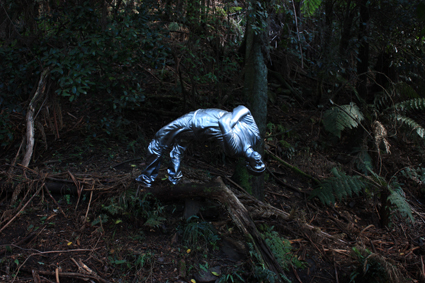Environmentally integrated art-making
Katerina Sakkas: Sculpture at Scenic World

Louis Pratt, A Backwards Attitude
photo Katerina Sakkas
Louis Pratt, A Backwards Attitude
It begins with a dive 310 metres down into the lush Jurassic rainforest of the Jamison Valley. From here you disembark onto the Lilli Pilli Link, a winding boardwalk which takes you on a 30-minute stroll through the forest past the 30 sculptures comprising this year’s Sculpture at Scenic World.
The competition, now in its third year, faces considerable environmental and aesthetic challenges presented by the highly sensitive nature of its rainforest location. Even some of the mossy rocks, my guide tells me, harbour ecosystems which have taken millions of years to evolve. The weight of artworks must be taken into consideration to avoid soil compaction. The entire exhibition takes an intensive three weeks to install and remains in situ for another three.
Alongside these environmental concerns stands the aesthetic problem of how to make artwork resonate conceptually and visually in such imposing surroundings. To attempt to make a bold statement is almost futile; the forest tends to dwarf sculptures, to swallow them up. Most artworks selected by this year’s judges—Anthony Bond, Binghui Huangfu and Richard Goodwin—have been designed to emerge subtly from the brilliant tangle of vines, foliage and rocks. Encountering even the larger works among the abundance of natural forest detail is like stumbling across some small natural curiosity on a bushwalk: a nest or a cluster of berries.
A few of the most effective pieces are not immediately prepossessing but gain power the longer you look at them, raising questions about the relationship between man-made and natural. In Jacqueline Spedding’s winning entry Transcend, a large cluster of white flowerpots hangs in a state of discolouration and decay from the sinewy branches of a tree vine and spreads onto the ground below. At first glance the effect is slightly jarring: an impression of tacky intrusion. But pause a little longer to examine these distressed production-line objects—each actually an individual ceramic piece crafted by Spedding—and an uneasy meditation on the fragile barrier between the domestic and the wild arises.
A similar theme is apparent in Network Breakdown by DoGsWooD, a work which first assails the eye with an awkward collection of what appear to be steel aircon ducts, or perhaps filing cabinets, sprawling down a small slope. As with Spedding’s work, however, a closer look reveals the organic taking over in the form of an extensive root system joining box to box and blending into the environment, connecting the machine-made to the earth in a display of Cronenbergian mutation. In a further twist, while the boxes appear to be steely the entire work is sculpted wood.
This masquerading of the hand-made behind a deceptively machined appearance reaches its peak in Louis Pratt’s contorted life-size figure, A Backwards Attitude. Metallic, slick and out of place, yet strangely confident in its prehistoric forest surrounds, it’s a 3D print, the very definition of hands-off process—until you learn that Pratt himself built the printer that realised the sculpture.
While these three works occupy an interesting grey area between artificiality and nature, other sculptures fall on either side of the more straightforward divide between minimalist abstraction and idiosyncratic whimsy. CULKIN+GEYER’s Uh-uh! A forest! A big dark forest, cuts through the intricate curves of the landscape with hard-edged bars of colour, suspended yet heavy to the eye, while around the corner Ana Carter’s Dream Catchers, assembled from mattress frames and other found objects, demonstrates a more personal engagement with flora and fauna. Continuing the whimsical strain, Todd Fuller’s pastel ceramic bunny men enact a dark tableau, adding a note of subversive weirdness.
The feature sculpture in the exhibition, Ken Unsworth’s Harlequin’s Shuttle, isn’t easily categorised. Commissioned especially for Sculpture at Scenic World by curator Lizzy Marshall, the work’s title describes it aptly. In an elegant pattern of coloured perspex it rises, ever so slightly off kilter, in the manner of some exquisite stained glass sci-fi religious monument, alternately glowing and dulling with the changing light. The lyrebirds apparently love it.
The lone sound work in the exhibition, Three Phases of the Dark Moon, is located within the darkness of a reconstructed coal miner’s hut on the boardwalk. David Sudmalis has composed a sonorous melodic piece incorporating infrasonic sound; the sombre quality lends itself to meditation while simultaneously underlining the closeness and darkness of the hut. To enter is to escape the sheer scale of the forest for a more intimate space redolent of recent human history.
There’s a sense at Sculpture at Scenic World that spectacle isn’t the main game here; a welcome absence of brashness that can afflict other open-air sculpture competitions. Thanks as much to curator Lizzy Marshall and the considerable efforts of the installation team as to the artists involved, this year’s exhibition inevitably draws our attention, in contrasting ways, to the unique environment which houses it.
Sculpture at Scenic World: 2014 Exhibition, Katoomba, 24 April-18 May
RealTime issue #121 June-July 2014 pg. 54






